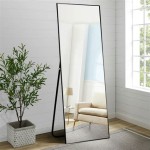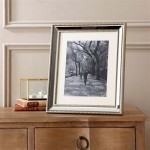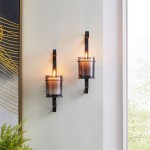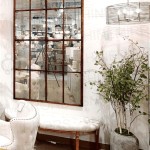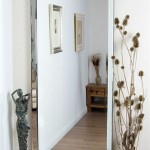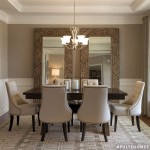Bathroom Mirror with Tile Border
A bathroom mirror with a tile border offers a sophisticated and customizable design element to any bathroom. The combination of reflective surface and decorative tile creates a focal point, enhancing the overall aesthetic. This article explores various aspects of incorporating a tiled mirror into bathroom design, from material choices to installation techniques.
Material Selection for Tile Borders
Selecting the right tile for a mirror border involves considering both aesthetics and practicality. The chosen material should complement the existing bathroom décor while withstanding the humid bathroom environment.
- Ceramic and Porcelain Tiles: These are popular choices due to their durability, water resistance, and wide variety of colors, patterns, and textures.
- Glass Tiles: Glass tiles add a touch of elegance and reflect light, making the bathroom appear brighter. They are available in various colors and finishes, including iridescent and frosted options.
- Stone Tiles: Natural stone like marble, travertine, or slate creates a luxurious and natural look. However, stone tiles require sealing to prevent water damage and staining.
- Metal Tiles: Metal tiles, such as stainless steel or aluminum, offer a modern and industrial aesthetic. They are durable and easy to clean.
- Mosaic Tiles: Mosaic tiles, composed of small pieces of glass, ceramic, or stone, allow for intricate designs and patterns, adding a unique touch to the mirror frame.
Mirror Types for Tiled Borders
The type of mirror also plays a crucial role in the final design. Different mirror shapes and sizes require different tiling approaches.
- Frameless Mirrors: Frameless mirrors provide a clean and modern look, allowing the tile border to become the primary decorative element.
- Beveled Mirrors: Beveled mirrors have angled edges, creating a subtle frame effect. This can complement a tile border by adding depth and dimension.
- Custom-Shaped Mirrors: Custom shapes, such as oval, round, or arched mirrors, offer unique design possibilities and necessitate careful tile selection and installation.
Design Considerations for Tile Borders
Several design elements influence the overall impact of a tiled mirror.
- Tile Size and Shape: Smaller tiles create intricate patterns, while larger tiles offer a bolder, more contemporary look. Consider the overall size of the mirror and the bathroom when choosing tile dimensions.
- Color Palette: The tile color should complement the existing bathroom color scheme. Contrasting colors create a dramatic effect, while complementary colors offer a more harmonious appearance.
- Grout Color: Grout color significantly impacts the final look. Contrasting grout emphasizes the tile shape, while matching grout creates a seamless appearance.
- Pattern and Layout: Various tile laying patterns, such as herringbone, subway, or chevron, can add visual interest to the border.
Installation Techniques for Tile Borders
Proper installation ensures the longevity and aesthetic appeal of the tiled mirror. Several techniques can be employed depending on the project's specifics.
- Direct Application to Mirror: This method involves applying thin-set mortar directly to the mirror surface and adhering the tiles. This requires a strong adhesive suitable for glass surfaces.
- Creating a Frame Backing: Building a frame from plywood or other suitable material and then tiling onto the frame provides a more robust structure, especially for larger mirrors.
- Tiling the Wall Around the Mirror: This creates a tiled backdrop for the mirror, effectively integrating it into the wall design.
Maintenance and Care
Maintaining a tiled mirror involves regular cleaning to prevent buildup of grime and water spots.
- Regular Cleaning: Wipe the mirror and tiles with a damp cloth and a mild cleaning solution designed for bathroom surfaces.
- Grout Cleaning: Periodically clean the grout with a grout cleaner to prevent mildew and staining.
- Sealing (for Natural Stone): If using natural stone tiles, ensure they are sealed regularly to prevent water penetration and staining.
Planning and Budgeting
Careful planning and budgeting are crucial for a successful project.
- Measurements: Accurately measure the mirror and calculate the required tile quantity, accounting for cuts and waste.
- Material Costs: Research and compare prices for tiles, adhesives, grout, and other necessary materials.
- Installation Costs: Factor in installation costs if professional installation is required.
Enhancing Bathroom Aesthetics with Tiled Mirrors
A bathroom mirror with a tile border serves as more than just a reflective surface; it becomes a design element that significantly enhances the bathroom's aesthetic appeal. Careful consideration of materials, design, and installation techniques ensures a beautiful and functional addition to any bathroom space.

Diy Mosaic Tile Bathroom Mirror Centsational Style

Diy Mosaic Tile Bathroom Mirror Centsational Style

Diy Mosaic Tile Bathroom Mirror Centsational Style

How To Mosaic Tile A Mirror Caffeine And Cabernet

Pin By Colleen On D I Y Mirror Decor Bathroom Frame Diy

How To Decorate A Mirror With Tile Sand And Sisal

How To Mosaic Tile A Mirror Caffeine And Cabernet

Glass Tiles Around Mirror Jazzes Up Any Bathroom So Easy Design Diy Vanity

How To Frame A Bathroom Mirror With Mosaic Tile Hometalk

Tile Mirror Border Super Easy Bathroom Redo Tiles Diy

